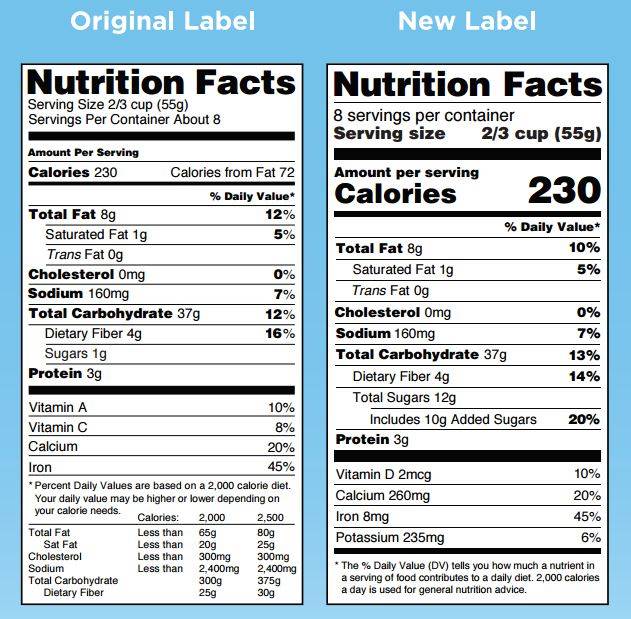What Does the New Food Facts Label Mean for You the Consumer
TEXARKANA, Ark. –
We have had the same nutrition facts food label for more than 20 years. The nutrition facts label helps us better understand what nutrition we are and are not getting in the food product. The new label is easier to read and will help you make better informed food choices. In return, it will help you take better control of your health and take steps to reduce the risk of chronic diseases and obesity.
A new food label was introduced that will start appearing on food products, although it won’t be immediate. Most food manufactures have until July 2018 to implement the new label on their products. So don’t expect to see it in stores immediately.
The new Nutrition Facts label is different in numerous ways. It will include an updated design to highlight “calories” and “servings.” Serving sizes are now being labeled in common household measures. For example, the reference amount for ice cream increased from one-half cup to two-thirds cup, and soda increased from 8 to 12 oz. Package sizes between one and two servings that people typically eat in one sitting, such as a 15-oz can of soup, now will be labeled as one serving.
Added sugar will now be on the label with percent Daily Value, (%DV) for added sugar on the Nutrition Facts Panel. The addition of added sugars on the label should assist consumers in making informed choices. The total sugars that you will see listed on the label reflects just that, the total sugars in the product, both naturally occurring and added sugars.
Vitamin D and potassium are replacing vitamins A and C as nutrients of public health significance and will now be mandatory on all labels. Vitamins A and C are no longer mandatory but you may still see them on the label. Potassium is really an undervalued nutrient beneficial in helping reduce the risk of chronic disease. The addition of potassium to the food label will help consumers know how much of this important mineral is in foods, and help identify foods higher in potassium.
While calcium and iron will still be required on Nutrition Facts labels, the nutrients of public health significance will be labeled in the following order: vitamin D, calcium, iron, and potassium, along with the actual gram amount and % DV, daily value. When any other voluntary vitamin and mineral is declared, it also must be labeled in actual amounts along with the % DV, instead of the current labeling of only the % DV.
You will no longer see the words, “calories from fat”; instead you will see the larger bold word “Calories”. Calories from fat will be removed because research shows the type of fat is more important than the amount. You will continue to see the words, “total fat, saturated fat, and trans fat.”
The footnote at the new label will better explain what % Daily Value (DV) means. It will state: “The % Daily Value tells you how much a nutrient in a serving of food contributes to a daily diet.” 2,000 calories a day is used for general nutrition advice. Whereas the old label gave information as it related to a 2,000 and 2,500 calorie diet.
As you start seeing the new nutrition facts foods labels on products, notice how much easier they are to read and hopefully how they improve your awareness of how much and what you are consuming. Hopefully you will check out the new nutrition label to help you make better food choices.
For more information, contact the Miller County Extension Office, 870-779-3609 or visit us in room 215 at the Miller County Courthouse. We're online at chadley@uada.edu, on Facebook at UAEXMillerCountyFCS/CarlaHaleyHadley, on Twitter @MillerCountyFCS or on the web at uaex.uada.edu/Miller.
By Carla Haley-Hadley
County Extension Agent - FCS
The Cooperative Extension Service
U of A System Division of Agriculture
Media Contact: Carla Haley-Hadley
County Extension Agent - FCS
U of A Division of Agriculture
Cooperative Extension Service
400 Laurel Street, Suite 215 Texarkana AR 71854
(870) 779-3609
chadley@uada.edu
Related Links
The Arkansas Cooperative Extension Service is an equal opportunity institution. If
you require a reasonable accommodation to participate or need materials in another
format, please contact your County Extension office (or other appropriate office)
as soon as possible. Dial 711 for Arkansas Relay.
Pursuant to 7 CFR § 15.3, the University of Arkansas System Division of Agriculture
offers all its Extension and Research programs and services (including employment)
without regard to race, color, sex, national origin, religion, age, disability, marital
or veteran status, genetic information, sexual preference, pregnancy or any other
legally protected status, and is an equal opportunity institution.
